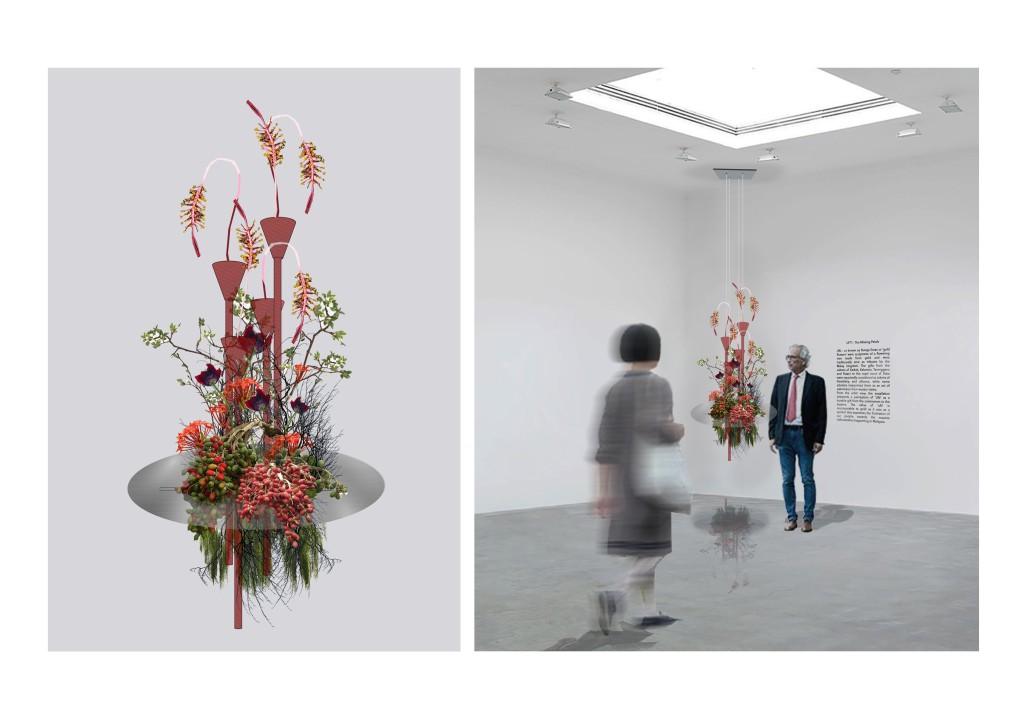Ufti was an idea developed between two close-friends, Siti Nur Dini Mahazan and Sarah Rahman, from Selangor, Malaysia. They have different roles within the arts academia with one a researcher and the other an academician, but they share a common passion as art installation artists. They have different academic backgrounds in art and design fields. Dini and Sarah have explored the relevance of art in the world of education at large. Since 2018 they have produced art installations that occasionally explore different interpretation and communication to express their thoughts, opinions, or feelings in regard to the unfavorable prevailing issues.
Artist Statement
Ufti, known as bunga emas or ‘gold flowers’ are sculptures of a flowering tree made using gold that was traditionally sent as tributes by the Malay kingdom. They were gifts from the sultans of Kedah, Kelantan, Terengganu, and Patani to the royal court of Siam were reportedly considered as tokens of friendship and alliance, while some scholars interpreted them as an act of submission from weaker states. The artist’s point of view was that the installation interprets a perception of ufti as a humble gift from the commoners to the leaders.The value of ufti is incomparable to gold as it acts as a symbol that expresses the frustration of their people toward the massive deforestation happening in Malaysia.
In Malay, bunga means flower, and raya refers to a celebration. Bunga raya literally means celebratory flower. In the past, the prominence of the Queen of Tropical Flowers could be seen alongside the roads in Malaysia that radiated the spirit of patriotism to the people where it symbolizes bravery to face challenges and rapid economic growth while projecting unity in the multi-racial population of the country.
However, little did we know that the bunga raya flower itself is a part of the endangered species listed in the International Union for Conservation of Nature (IUCN), under the red list of endangered plants. As the urban development of Malaysia grows to spoon-feeding the greedy, the notability of bunga raya has lost its prominence, leaving only the structure (the epicalyx and stamens) without its content (the five petals).
Using the Malaysian national flower, the red hibiscus or bunga raya, the installation depicts the disappearance of the five petals which represent the five rukun negara, the principle of Nationhood of Malaysia. Thousands of words could not describe the importance of the Bunga Raya as the subject of the installation, and also serves to highlight its future extinction due to the massive deforestation occuring in Malaysia. The repercussion of the leaders’ actions not only jeopardise the existence and habitat of the national flower, but also dismisses the spirit of rukun negara among the rakyat.
The ufti aims to spark conversation among leaders and also to question the obsolescence of bunga raya – the identity and the Rukun Negara (the national principles).
Installation Components & Materials
The hanging installation extracts the five petals of bunga raya along with the embedded three remaining components: the epicalyx, stamen, and stigma. It uses a circular hollow steel material to hold the entire component and to envelop its form with a steel wire and wire mesh. A replica of tropical plants and dry plants are wrapped around and underneath to imitate the under-rated buah pinang, bunga jenjarum and the additional beauty of tropical plant imperfections.
